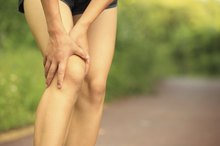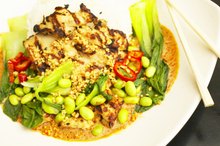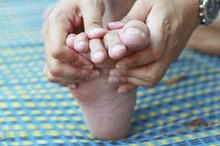Relationship Between Protein Intake and Joint Pain
The relationship between protein intake and joint pain is a complex and sometimes misunderstood one. Joint pain itself is confusing because there are so many different causes. Recently, it has been shown that a diet high in protein may worsen joint pain in people with some medical conditions.
If you are experiencing serious medical symptoms, seek emergency treatment immediately.
Arthritis
Arthritis is a condition that involves chronic pain and inflammation of the joints. For people with arthritis, eating protein-rich foods often may actually worsen joint pain. A low protein diet may help reduce the symptoms of arthritis, such as inflammation and pain.
Fibromyalgia
Can Shingles Affect Your Joints?
Learn More
Fibromyalgia is a chronic condition involving pain in the joints and muscles. A journal published in the Scandinavian Journal of Rheumatology suggests that a vegan diet alleviates symptoms of fibromyalgia such as joint pain. Vegan diets exclude meat, eggs and dairy, which are all high in protein. Therefore, it can be presumed that a low protein diet may help relieve joint pain.
- Fibromyalgia is a chronic condition involving pain in the joints and muscles.
- A journal published in the Scandinavian Journal of Rheumatology suggests that a vegan diet alleviates symptoms of fibromyalgia such as joint pain.
Purines
Many foods that are high in protein contain organic compounds called purines, which are converted into uric acid by the body. In some people, such as those who have a condition called gout, eating foods high in purines causes extreme pain. Low protein diets (which are usually also low in purines) can reduce joint pain caused by gout.
High Protein Foods
Fibromyalgia Knots
Learn More
High protein foods include meats such as beef, chicken, turkey and fish, as well as eggs and most dairy products. Beans, nuts and lentils are also high in protein, but do not have as much protein as animal products do.
Fruits and Vegetables
Most fruits and vegetables are low in protein and also low in calories. While protein can increase inflammation caused by arthritis, the antioxidants found in fruits and vegetables, combined with the fact that they are low in protein, mean they can actually reduce inflammation from arthritis.
Related Articles
References
- Centers for Disease Control and Prevention. Osteoarthritis (OA). Updated January 10, 2019.
- MedlinePlus. Osteoarthritis. Updated January 6, 2020.
- Banks SE. Erosive osteoarthritis: a current review of a clinical challenge. Clin Rheumatol. 2010;29(7):697-706. doi:10.1007/s10067-009-1369-7
- Engel B, Just J, Bleckwenn M, Weckbecker K. Treatment options for gout. Dtsch Arztebl Int. 2017;114(13):215-222. doi:10.3238/arztebl.2017.0215
- MacMullan P, McCarthy G. Treatment and management of pseudogout: insights for the clinician. Ther Adv Musculoskelet Dis. 2011;4(2):121-131. doi:10.1177/1759720x11432559
- Arthritis Foundation. Infectious arthritis.
- Marks M, Marks JL. Viral arthritis. Clin Med (Lond). 2016;16(2):129-134. doi:10.7861/clinmedicine.16-2-129
- Sierakowski S, Cutolo M. Morning symptoms in rheumatoid arthritis: a defining characteristic and marker of active disease. Scand J Rheumatol. 2011;40(sup125):1-5. doi:10.3109/03009742.2011.566433
- Spondylitis Association of America. Overview of types of spondylitis.
- National Psoriasis Foundation. Psoriatic arthritis. Updated December 28, 2018.
- Gladman DD, Ritchlin C. Patient education: Psoriatic arthritis (Beyond the basics). UpToDate. Updated February 5, 2018.
- National Organization for Rare Disorders. Reactive Arthritis.
- Arvikar SL, Fisher MC. Inflammatory bowel disease associated arthropathy. Curr Rev Musculoskelet Med. 2011;4(3):123-131. doi:10.1007/s12178-011-9085-8
- Lam NC, Ghetu MV, Bieniek ML. Systemic lupus erythematosus: Primary care approach to diagnosis and management. Am Fam Physician. 2016;94(4):284-94.
- Docken WP. Clinical manifestations and diagnosis of polymyalgia rheumatica. UpToDate. Updated October 8, 2019.
- Goldenberg DL. Patient education: Fibromyalgia (Beyond the basics). UpToDate. Updated June 21, 2018.
- National Institute of Diabetes and Digestive and Kidney Diseases. Hashimoto's disease. Updated September 2017.
- Jaracz J, Gattner K, Jaracz K, Górna K. Unexplained painful physical symptoms in patients with major depressive disorder: Prevalence, pathophysiology and management. CNS Drugs. 2016;30(4):293-304. doi:10.1007/s40263-016-0328-5
- Solmaz D, Bakirci S, Kimyon G, et al. The impact of having family history of psoriasis or psoriatic arthritis on psoriatic disease. Arthritis Care Res (Hoboken). 2020;72(1):63-68. doi:10.1002/acr.23836
- Fouladbakhsh J. Complementary and alternative modalities to relieve osteoarthritis symptoms: A review of the evidence on several therapies often used for osteoarthritis management. Orthop Nurs. 2012;31(2):115-121. doi:10.1097/nor.0b013e31824fce6e
- Wandel S, Jüni P, Tendal B, et al. Effects of glucosamine, chondroitin, or placebo in patients with osteoarthritis of hip or knee: network meta-analysis. BMJ. 2010;341:c4675. doi:10.1136/bmj.c4675
- American Academy of Orthopaedic Surgeons. Osteotomy of the knee. Updated June 2017.
- Marks M, Marks JL. Viral arthritis. Clin Med (Lond). 2016 Apr;16(2):129-34. doi:10.7861/clinmedicine.16-2-129
- Pujalte G, Albano-Aluquin SA. Differential Diagnosis of Polyarticular Arthritis. Am Fam Physician. 2015 Jul 1;92(1):35-41.
- Shmerling RH. (2017). Evaluation of the adult with polyarticular pain. Maini RN, ed. UpToDate. Waltham, MA: UpToDate Inc.
- Skou ST, Roos EM, Laursen MB, et al. A Randomized, Controlled Trial of Total Knee Replacement. N Engl J Med. 2015;373(17):1597-1606. doi:10.1056/NEJMoa1505467
Writer Bio
Sarah Davis has worked in nutrition in the clinical setting and currently works as a licensed Realtor in California. Davis began writing about nutrition in 2006 and had two chapters published in "The Grocery Store Diet" book in 2009. She enjoys writing about nutrition and real estate and managing her website, RealtorSD.com. She earned her bachelor's degree in nutrition from San Diego State University.








